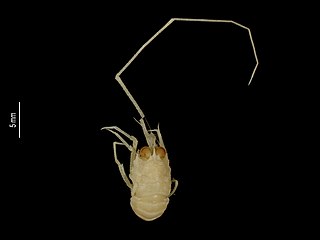
Squat lobsters are dorsoventrally flattened crustaceans with long tails held curled beneath the cephalothorax. They are found in the two superfamilies Galatheoidea and Chirostyloidea, which form part of the decapod infraorder Anomura, alongside groups including the hermit crabs and mole crabs. They are distributed worldwide in the oceans, and occur from near the surface to deep sea hydrothermal vents, with one species occupying caves above sea level. More than 900 species have been described, in around 60 genera. Some species form dense aggregations, either on the sea floor or in the water column, and a small number are commercially fished.

The Galatheidae are a family of squat lobsters.

Galathea strigosa is a species of squat lobster in the family Galatheidae. It is found in the northeast Atlantic Ocean, from the North Cape to the Canary Islands, and in the Mediterranean Sea and Red Sea. It is edible, but not fished commercially. It is the largest squat lobster in the northeast Atlantic, reaching a length of 90 millimetres (3.5 in), or a carapace length of 53 mm (2.1 in), and is easily identified by the transverse blue stripes across the body.
Hapaloptyx difficilis is a species of squat lobster in a monotypic genus in the family Chirostylidae.

Chirostylus is a genus of squat lobsters in the family Chirostylidae, containing the following species:
Pseudomunida fragilis is a species of squat lobster in a monotypic genus in the family Eumunididae.
Uroptychodes is a genus of squat lobsters in the family Chirostylidae, containing the following species:

Alainius crosnieri is a species of squat lobster in a monotypic genus in the family Galatheidae.
Anomoeomunida is a monotypic squat lobster genus in the family Munididae. The sole a species of is Anomoeomunida caribensis. It occurs in the western Atlantic.

Anoplonida is a genus of squat lobsters, which are flattened dorsoventrally, in the family Munididae, containing the following species:

Bathymunida is a genus of squat lobsters in the family Munididae, containing the following species:
Enriquea leviantennata is a species of squat lobster in a monotypic genus in the family Munididae.
Fennerogalathea is a genus of squat lobsters in the family Galatheidae, containing the following species:

Heteronida is a genus of squat lobsters in the family Munididae. They occur in the western Pacific Ocean.

Lauriea is a genus of squat lobsters in the family Galatheidae, containing the following species:

Neonida grandis is a species of squat lobster in a monotypic genus in the family Munididae.
Phylladiorhynchus is a genus of squat lobsters in the family Galatheidae, containing the following species:

Shinkaia crosnieri is a species of squat lobster in a monotypic genus in the family Munidopsidae. S. crosnieri lives in deep-sea hydrothermal vent ecosystems, living off of the chemosynthetic activity of certain bacteria living on its setae.
Tasmanida norfolkae is a species of squat lobster in a monotypic genus in the family Munididae.

Chirostyloidea is an anomuran superfamily with squat lobster-like representatives. It comprises the three families Chirostylidae, Eumunididae and Kiwaidae. Although representatives of Chirostyloidea are superficially similar to galatheoid squat lobsters, they are more closely related to Lomisoidea and Aegloidea together forming the clade Australopoda. No fossils can be confidently assigned to the Chirostyloidea, although Pristinaspina may belong either in the family Kiwaidae or Chirostylidae.










